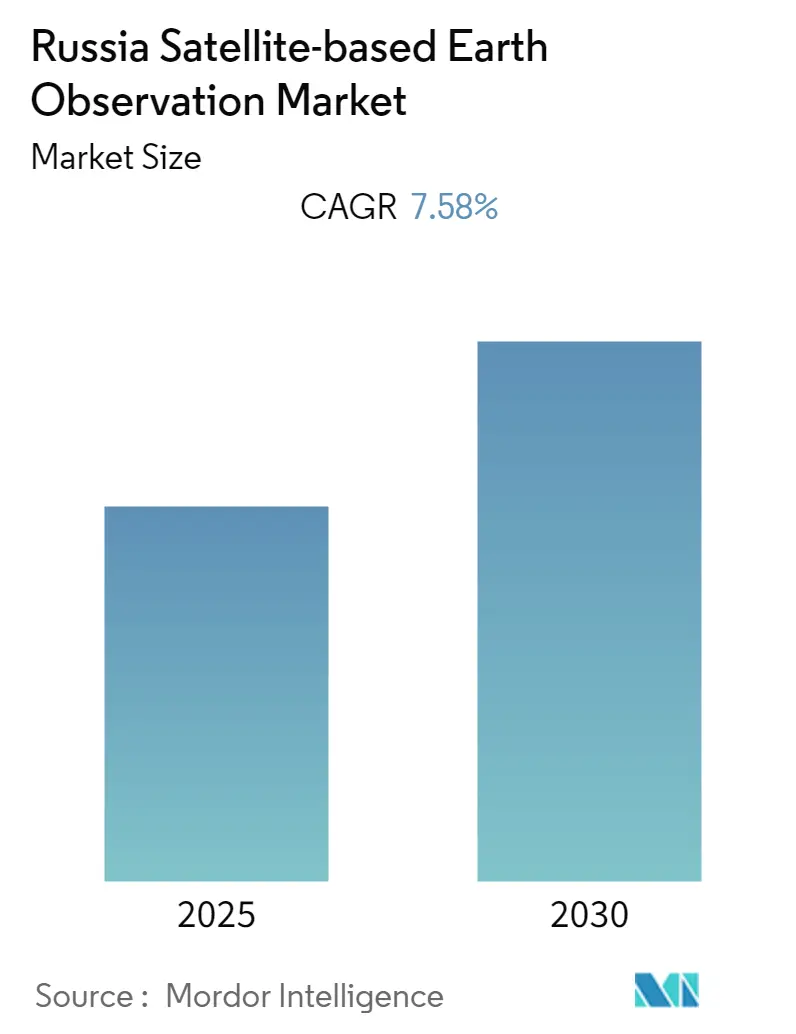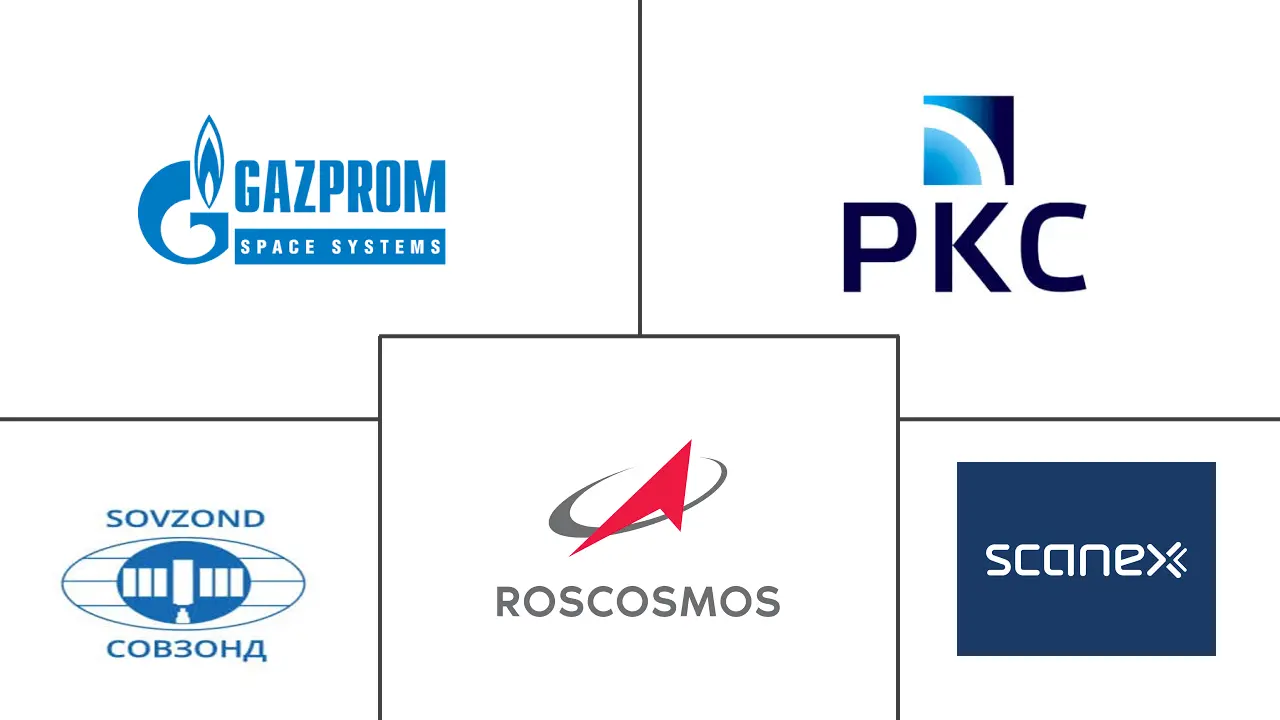
Russia Satellite-based Earth Observation Market Analysis
The Russia Satellite-based Earth Observation Market is expected to register a CAGR of 7.58% during the forecast period.
Satellite-based Earth observation plays a crucial role in national security and defense activities. Russia's need for advanced surveillance capabilities and situational awareness will likely drive demand for satellite imagery and data.
- Russia's satellite-based Earth observation market refers to the industry involved in developing, operating, and utilizing satellite systems and services for observing and collecting data about the Earth's surface and atmosphere. It encompasses satellite imagery, remote sensing, and geospatial data applications for various sectors, including urban development and cultural heritage, agriculture, environment, and infrastructure.
- Russia has a long history and significant expertise in space technology and satellite-based Earth observation. The country operates a constellation of satellites designed for different purposes, including remote sensing, meteorology, and scientific research. A mix of government initiatives, commercial services, and collaborations with international partners characterizes the market.
- In addition, the Russian government has been actively promoting the development of the space industry, including satellite-based Earth observation. Government initiatives, policies, and funding support drive the market's growth. This includes investments in satellite systems, infrastructure development, and research and development activities.
- Further, Russia's vast territory and diverse ecosystems necessitate continuous environmental monitoring and resource management. Satellite-based Earth observation provides valuable data for monitoring deforestation, climate change impacts, natural disasters, and managing natural resources such as oil, gas, minerals, and water reserves. The market's growth is driven by the increasing focus on sustainable development and the need for efficient resource management.
- However, limited funding and budgetary constraints can impede the development and deployment of satellite-based Earth observation systems. The high costs associated with satellite manufacturing, launch, and operations pose challenges for government agencies and commercial entities. Insufficient financial resources can restrict acquiring advanced satellite systems, infrastructure development, and research and development activities.
Russia Satellite-based Earth Observation Market Trends
Government Initiatives and Support to Drive the Market Growth
- Government initiatives and support play a crucial role in shaping the development and growth of Russia's satellite-based earth observation market. The government's commitment to space activities, including earth observation, significantly drives innovation, investment, and market expansion.
- As evidenced by budget allocations, the Russian government's financial commitment to space activities is a crucial driver in the satellite-based earth observation market. Government funding provides the necessary resources for research, development, infrastructure, and the deployment of satellites. It supports technological advancements, data processing capabilities, and the expansion of satellite networks, enabling the market to grow and thrive.
- Government initiatives and support contribute to the establishment of favorable policies and regulations for the satellite-based earth observation market. This includes licensing procedures, spectrum allocation, data privacy, and security regulations. Clear and supportive policies create a conducive environment for businesses, attract investment, and foster innovation, driving the market forward.
- Additionally, the government's initiatives encourage collaborations between public and private entities, research institutions, and industry stakeholders. Partnerships facilitate knowledge sharing, technological exchange, and joint research and development efforts. Collaborative initiatives foster innovation, drive the advancement of satellite-based earth observation technologies, and promote the emergence of new market players.

Agriculture Segment is Expected to Hold a Significant Market Share
- The agriculture end-use segment plays a crucial role in the Russian satellite-based earth observation market. With a significant agricultural sector and vast land areas, satellite-based earth observation technologies provide valuable data and insights that optimize agricultural practices, increase productivity, and improve resource management.
- Satellite data assists yield estimation and forecasting by providing insights into crop conditions, growth patterns, and overall productivity. This information is vital for farmers, agricultural insurers, and policymakers to assess potential harvests, manage supply chains, and make informed decisions regarding market dynamics, resource allocation, and risk management.
- Moreover, satellite-based earth observation data is often integrated with other data sources, such as weather data, soil data, and crop models. This integration enables comprehensive analysis and decision-making processes, facilitating more accurate predictions, improved risk management, and enhanced agricultural outcomes.
- Further, satellite-based earth observation data provides policymakers and agricultural planners with valuable information. It aids in assessing agricultural land suitability, identifying areas of potential expansion, and optimizing land use planning. Satellite data also support policy formulation related to agricultural subsidies, disaster response, and climate change adaptation in agriculture.
- According to the Russian Federal State Statistics Service, the value of agricultural production in Russia has shown a steady increase over the specified period. In 2022, the total value rose by approximately 15% compared to the previous year, reaching RUB 8.85 trillion (USD 0.1 trillion). This growth indicates an expanding agriculture sector and a potential rise in demand for technologies and services that facilitate agricultural optimization, including satellite-based earth observation. As the agricultural industry expands, the need for satellite data to monitor crop health, optimize resource allocation, and improve productivity becomes more significant.

Russia Satellite-based Earth Observation Industry Overview
The Russia satellite-based earth observation market is expected to be moderately consolidated. Several key players have emerged from government entities and private companies over the years. These players have developed advanced satellite systems, data processing capabilities, and expertise in delivering satellite-based earth observation services. They often have established partnerships, collaborations, and contracts with government agencies, research institutions, and other stakeholders in the market.
In May 2023, Roscosmos announced that the Kondor-FKA No. 1 civilian radar observation satellite had entered its intended orbit. It is ready to offer round-the-clock, all-weather monitoring of the continents and the world ocean. The Research and Production Association of Machine-Building created the Kondor line of miniature Earth remote-sensing satellites for the Aerospace Defence Forces and other international clients.
In December 2022, the Russian space agency announced that the agency would borrow up to RUB 50 billion (USD 710 million) in 2023 to fund a massive satellite-building program to catch up to the United States and China. Roscosmos said it would increase its ability to develop and launch satellites for the Russian government and commercial businesses by putting publicly traded bonds on the country's financial markets throughout the upcoming year.
Russia Satellite-based Earth Observation Market Leaders
-
Russian Space Systems JSC
-
The State Space Corporation (Roscosmos)
-
SCANEX Group
-
Sovzond Company
-
JSC Gazprom Space Systems
- *Disclaimer: Major Players sorted in no particular order
Russia Satellite-based Earth Observation Market News
- April 2023: The Russian government made a commitment to maintain its participation in the International Space Station (ISS) through at least 2028. NASA has reported that Russia has affirmed its dedication to supporting the station until 2028. The other partners, including NASA, the Canadian Space Agency, the European Space Agency, and the Japan Aerospace Exploration Agency, have agreed to extend the station's operations through 2030.
- August 2022: The satellite, named "Khayyam" after a Persian mathematician from the 12th century, is set to launch as part of an agreement between Russia's Roscosmos space agency and Iran, a collaboration that has been in the works for nearly four years. The Kanopus-V system, developed and launched by Russia, will feature a high-resolution camera providing Tehran with potential capabilities, including near-constant monitoring of sensitive facilities in Israel and the Persian Gulf region.
Russia Satellite-based Earth Observation Industry Segmentation
Satellite-based earth observation is done with the help of satellites orbiting around the planet to view and identify environmental changes, map making, etc. Satellite-based earth observation technology captures and stores information from satellites relating to the physical, biological, and chemical compositions of the earth for monitoring, surveillance, and decision-making in various verticals, such as defense and intelligence, infrastructure and engineering, natural resource management, energy and power, and disaster management.
Russia satellite-based earth observation market is segmented by type (earth observation data, value-added services), satellite orbit (low earth orbit, medium earth orbit, and geostationary orbit), and end-use (urban development and cultural heritage, agriculture, climate services, energy and raw materials, infrastructure, and other end-use).
The market sizes and forecasts are provided in terms of value (USD) for all the above segments.
| By Type | Earth Observation Data |
| Value Added Services | |
| By Satellite Orbit | Low Earth Orbit |
| Medium Earth Orbit | |
| Geostationary Orbit | |
| By End-Use | Urban Development and Cultural Heritage |
| Agriculture | |
| Climate Services | |
| Energy and Raw Materials | |
| Infrastructure | |
| Other End-Use |
Russia Satellite-based Earth Observation Market Research Faqs
What is the current Russia Satellite-based Earth Observation Market size?
The Russia Satellite-based Earth Observation Market is projected to register a CAGR of 7.58% during the forecast period (2025-2030)
Who are the key players in Russia Satellite-based Earth Observation Market?
Russian Space Systems JSC, The State Space Corporation (Roscosmos), SCANEX Group, Sovzond Company and JSC Gazprom Space Systems are the major companies operating in the Russia Satellite-based Earth Observation Market.
What years does this Russia Satellite-based Earth Observation Market cover?
The report covers the Russia Satellite-based Earth Observation Market historical market size for years: 2019, 2020, 2021, 2022, 2023 and 2024. The report also forecasts the Russia Satellite-based Earth Observation Market size for years: 2025, 2026, 2027, 2028, 2029 and 2030.
Our Best Selling Reports
Russia Satellite-based Earth Observation Industry Report
Statistics for the 2025 Russia Satellite-based Earth Observation market share, size and revenue growth rate, created by Mordor Intelligence™ Industry Reports. Russia Satellite-based Earth Observation analysis includes a market forecast outlook for 2025 to 2030 and historical overview. Get a sample of this industry analysis as a free report PDF download.




